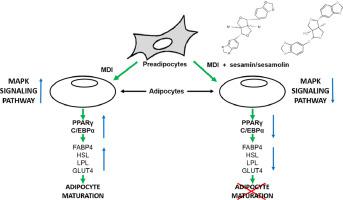当前位置:
X-MOL 学术
›
Nutr. Res.
›
论文详情
Our official English website, www.x-mol.net, welcomes your feedback! (Note: you will need to create a separate account there.)
Sesamin and sesamolin potentially inhibit adipogenesis through downregulating the peroxisome proliferator-activated receptor γ protein expression and activity in 3T3-L1 cells
Nutrition Research ( IF 4.5 ) Pub Date : 2023-12-25 , DOI: 10.1016/j.nutres.2023.12.011 Nelma Nyvonne Tiqu Gina , Jui-Ling Kuo , Mei-Li Wu , Show-Mei Chuang
Nutrition Research ( IF 4.5 ) Pub Date : 2023-12-25 , DOI: 10.1016/j.nutres.2023.12.011 Nelma Nyvonne Tiqu Gina , Jui-Ling Kuo , Mei-Li Wu , Show-Mei Chuang

|
Sesamin and sesamolin are major sesame lignans that have demonstrated anti-inflammatory, anticancer, and neuroprotective properties and potential benefits in the liver, cardiovascular diseases, and metabolic syndrome. However, despite previous research on their antiobesity effects and underlying mechanisms, a comprehensive investigation of these aspects is still lacking. In this study, we evaluated the regulatory effects of 20 to 80 µM sesamin and sesamolin on adipogenesis in vitro using 3T3-L1 cells as a model cell line. We hypothesized that the lignans would inhibit adipogenic differentiation in 3T3-L1 cells through the regulation of peroxisome proliferator-activated receptor γ (PPARγ). Our data indicate that sesamin and sesamolin inhibited the adipogenic differentiation of 3T3-L1 cells by dose-dependently decreasing lipid accumulation and triglyceride formation. Sesamin and sesamolin reduced the mRNA and protein expression of the adipogenesis-related transcription factors, PPARγ and CCAAT/enhancer-binding protein α, leading to the dose-dependent downregulations of their downstream targets, fatty acid binding protein 4, hormone-sensitive lipase, lipoprotein lipase, and glucose transporter 4. In addition, glucose uptake was dose-dependently attenuated by sesamin and sesamolin in both differentiated 3T3-L1 cells and HepG2 cells. Interestingly, our results suggested that sesamin and sesamolin might directly bind to PPARγ to inhibit its transcriptional activity. Finally, sesamin and sesamolin decreased the phosphorylation of 3 mitogen-activated protein kinase signaling components in differentiated 3T3-L1 cells. Taken together, our findings suggest that sesamin and sesamolin may exhibit antiobesity effects by potentially downregulating PPARγ and its downstream genes through the mitogen-activated protein kinase signaling pathway, offering important insights into the molecular mechanisms underlying the potential antiobesity effects of sesamin and sesamolin.
中文翻译:

芝麻素和芝麻林可能通过下调 3T3-L1 细胞中过氧化物酶体增殖物激活受体 γ 蛋白的表达和活性来抑制脂肪生成
芝麻素和芝麻林素是主要的芝麻木脂素,已被证明具有抗炎、抗癌和神经保护特性,以及对肝脏、心血管疾病和代谢综合征的潜在益处。然而,尽管之前对其抗肥胖作用和潜在机制进行了研究,但仍然缺乏对这些方面的全面研究。在本研究中,我们使用 3T3-L1 细胞作为模型细胞系,评估了 20 至 80 µM 芝麻素和芝麻林对体外脂肪生成的调节作用。我们假设木酚素会通过调节过氧化物酶体增殖物激活受体γ(PPARγ)来抑制3T3-L1细胞的脂肪形成分化。我们的数据表明,芝麻素和芝麻林通过剂量依赖性地减少脂质积累和甘油三酯形成来抑制 3T3-L1 细胞的脂肪形成分化。芝麻素和芝麻林降低脂肪生成相关转录因子 PPARγ 和 CCAAT/增强子结合蛋白 α 的 mRNA 和蛋白表达,导致其下游靶标脂肪酸结合蛋白 4、激素敏感性脂肪酶、脂蛋白脂肪酶和葡萄糖转运蛋白4。此外,在分化的3T3-L1细胞和HepG2细胞中,芝麻素和芝麻林剂量依赖性地减弱葡萄糖摄取。有趣的是,我们的结果表明芝麻素和芝麻林可能直接与 PPARγ 结合,抑制其转录活性。最后,芝麻素和芝麻林降低了分化的 3T3-L1 细胞中 3 种丝裂原激活蛋白激酶信号传导成分的磷酸化。综上所述,我们的研究结果表明,芝麻素和芝麻林可能通过丝裂原激活蛋白激酶信号通路下调 PPARγ 及其下游基因,从而表现出抗肥胖作用,这为了解芝麻素和芝麻林潜在抗肥胖作用的分子机制提供了重要的见解。
更新日期:2023-12-25
中文翻译:

芝麻素和芝麻林可能通过下调 3T3-L1 细胞中过氧化物酶体增殖物激活受体 γ 蛋白的表达和活性来抑制脂肪生成
芝麻素和芝麻林素是主要的芝麻木脂素,已被证明具有抗炎、抗癌和神经保护特性,以及对肝脏、心血管疾病和代谢综合征的潜在益处。然而,尽管之前对其抗肥胖作用和潜在机制进行了研究,但仍然缺乏对这些方面的全面研究。在本研究中,我们使用 3T3-L1 细胞作为模型细胞系,评估了 20 至 80 µM 芝麻素和芝麻林对体外脂肪生成的调节作用。我们假设木酚素会通过调节过氧化物酶体增殖物激活受体γ(PPARγ)来抑制3T3-L1细胞的脂肪形成分化。我们的数据表明,芝麻素和芝麻林通过剂量依赖性地减少脂质积累和甘油三酯形成来抑制 3T3-L1 细胞的脂肪形成分化。芝麻素和芝麻林降低脂肪生成相关转录因子 PPARγ 和 CCAAT/增强子结合蛋白 α 的 mRNA 和蛋白表达,导致其下游靶标脂肪酸结合蛋白 4、激素敏感性脂肪酶、脂蛋白脂肪酶和葡萄糖转运蛋白4。此外,在分化的3T3-L1细胞和HepG2细胞中,芝麻素和芝麻林剂量依赖性地减弱葡萄糖摄取。有趣的是,我们的结果表明芝麻素和芝麻林可能直接与 PPARγ 结合,抑制其转录活性。最后,芝麻素和芝麻林降低了分化的 3T3-L1 细胞中 3 种丝裂原激活蛋白激酶信号传导成分的磷酸化。综上所述,我们的研究结果表明,芝麻素和芝麻林可能通过丝裂原激活蛋白激酶信号通路下调 PPARγ 及其下游基因,从而表现出抗肥胖作用,这为了解芝麻素和芝麻林潜在抗肥胖作用的分子机制提供了重要的见解。



























 京公网安备 11010802027423号
京公网安备 11010802027423号